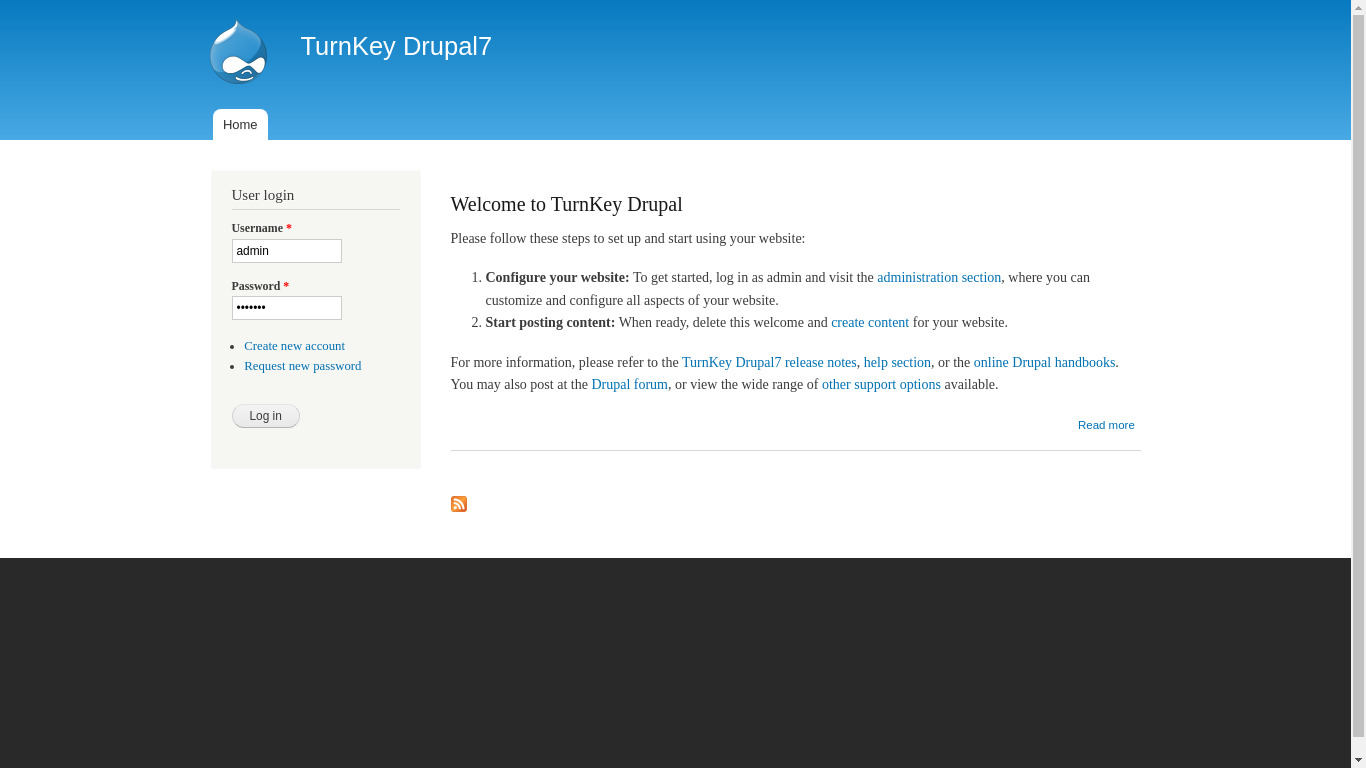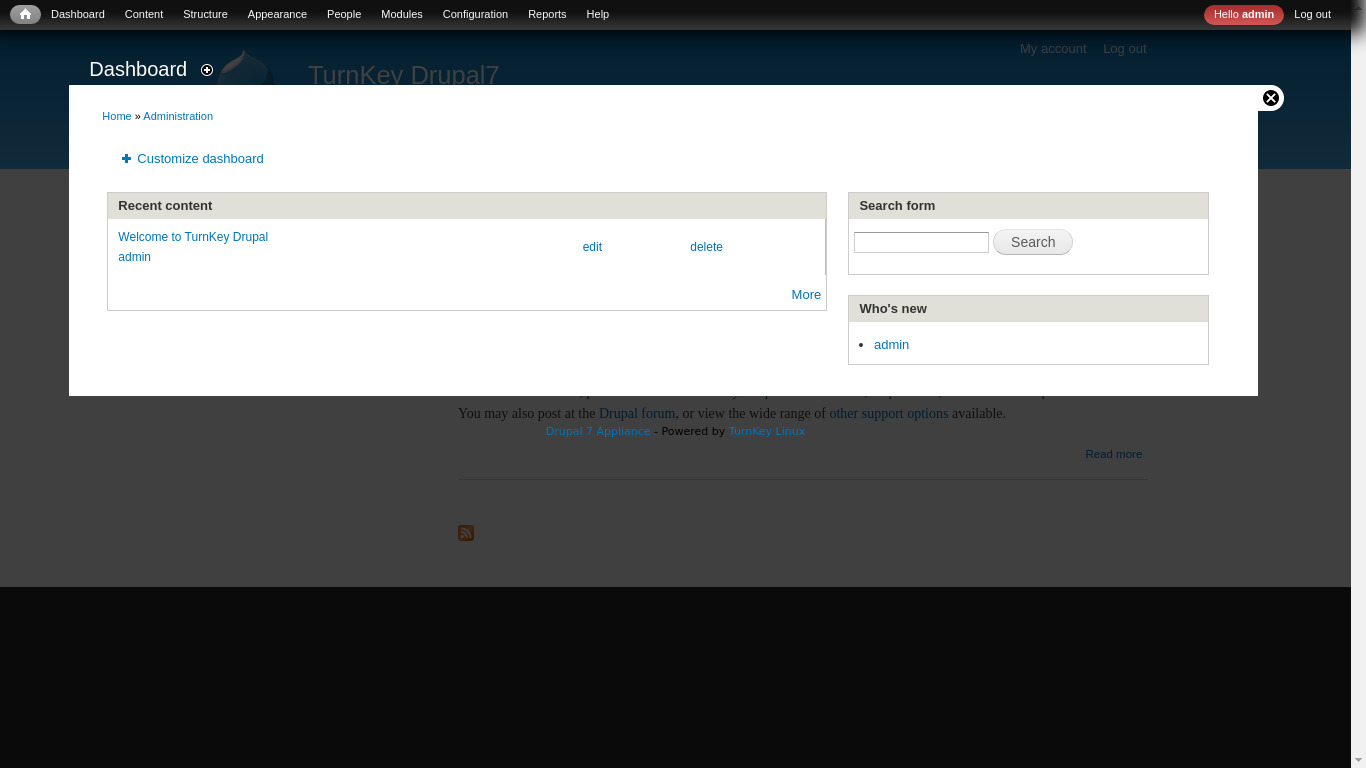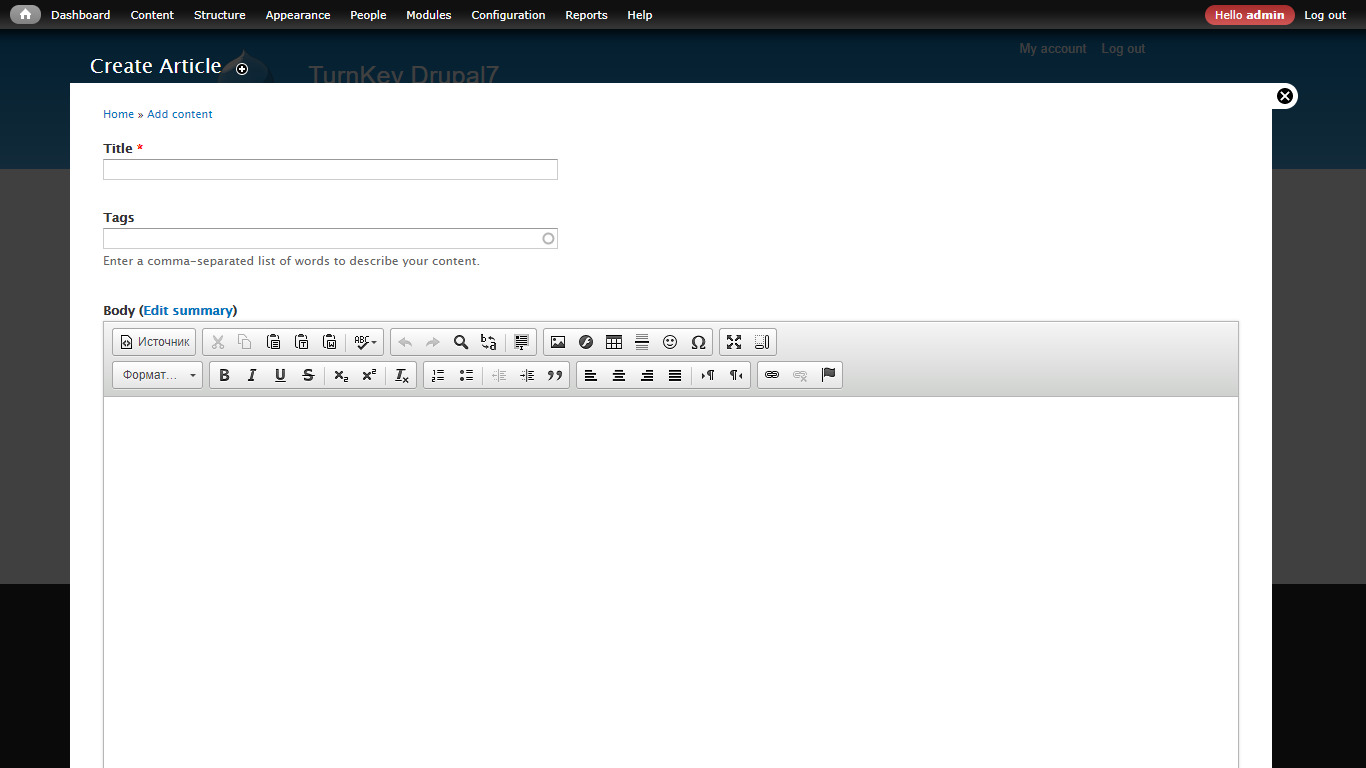You are here
Drupal 7
Content Management Framework
IMPORTANT NOTE: Drupal 7 is Extended life support until Jan 2025 - unless you need Drupal 7, Drupal users are strongly advised use Drupal 9 instead, or better still Drupal 10.
Drupal is an open source content management platform licensed under
the GPL. Equipped with a powerful blend of features, Drupal can support
a variety of websites ranging from personal blogs, corporate brochures
and large community-driven websites.
Run from browser
V 18.1
V 17.1
GitHub
This appliance includes all the standard features in TurnKey Core, and on top of that:
- Drupal 7 configurations:
- Installed (using drush) from upstream source code to /var/www/drupal7
Security note: Updates to Drupal may require supervision so they ARE NOT configured to install automatically. See below for updating Drupal.
- Includes drush for command line administration and configuration.
- Drupal security update alerts delivered to your inbox - requires Security Alerts ('secalerts') be enabled on firstboot with a valid email address.
- Installed (using drush) from upstream source code to /var/www/drupal7
- Bundled popular Drupal 7 modules and dependencies (installed to
/var/www/drupal7/sites/all/modules):
- Admin menu: Adds dropdown administration menu to the top of the screen.
- Admin views: Replaces administrative overview/listing pages with actual views for superior usability.
- Advanced_help: Improves the Drupal help system.
- Backup and migrate: Backup and restore your Drupal site on-demand or on a schedule.
- Ckeditor: Enables CKeditor (a WYSIWYG editor) instead of plain text fields.
- Colorbox: Light-weight customizable plugin to provide overlayed images (replaces previous inclusion of Lightbox2).
- Drush: a command line shell and Unix scripting interface for Drupal.
- Field group: Allows fields to be grouped together.
- GlobalRedirect: Alias 301 redirects, prevents duplicate content. (SEO)
- Google analytics: Adds Google Analytics js tracking code to all your site's pages.
- Honeypot: A honeypot for deterring spam bots from completing forms on your site (additionally uses timestamp method).
- Imce: Powerful image file uploader and browser, with support for on the fly resizing.
- Module filter: Allows modules on the modules list page to be filtered for easier reading.
- PathAuto: Auto-generate search engine friendly URLs (SEO).
- Rules: Lets you define conditionally executed actions based on occurring events.
- Token: Provides a shared API for replacement of textual placeholders with actual data.
- Views: Allows creation of dynamic pages ("views") of existing content.
- Note: Only some modules are enabled by default. To enable/disable
modules, navigate to Administer > Modules (or http://example.com/admin/modules). Some modules may require additional configuration and/or permissions settings.
- SSL support out of the box.
- Adminer administration frontend for MySQL (listening on port 12322 - uses SSL).
- Postfix MTA (bound to localhost) to allow sending of email (e.g., password recovery).
- Webmin modules for configuring Apache2, PHP, MySQL and Postfix.
Supervised Manual Drupal Update
It is possible to check for and install updates from the Drupal Admin UI:: Admin > Reports > Available Updates
Or from the command line:
drush pm-refresh drush pm-update --security-only --simulate drush pm-update --security-only
We also recommend that you subscribe to the drupal.org security newsletter (create a user account on drupal.org and within your drupal.org profile:: Edit > My newsletter tab).
Usage details & Logging in for Administration
No default passwords: For security reasons there are no default passwords. All passwords are set at system initialization time.
Ignore SSL browser warning: browsers don't like self-signed SSL certificates, but this is the only kind that can be generated automatically. If you have a domain configured, then via Confconsole Advanced menu, you can generate free Let's Encypt SSL/TLS certificates.
Web - point your browser at either:
- http://12.34.56.789/ - not encrypted so no browser warning
- https://12.34.56.789/ - encrypted with self-signed SSL certificate
Note: some appliances auto direct http to https.
Username for adminer:
Login as username adminer
Username for drupal 7:
Login as username admin
Username for database administration:
- Adminer; login as MySQL username adminer:
https://12.34.56.789:12322/ - Adminer database management web app
- MySQL command line tool; log in as root (no password required):
$ mysql --user root Welcome to the MySQL monitor. Commands end with ; or \g. Type 'help;' or '\h' for help. Type '\c' to clear the current input statement. mysql>
Username for OS system administration:
Login as root except on AWS marketplace which uses username admin.
- Point your browser to:
- https://12.34.56.789:12321/ - System control panel
- https://12.34.56.789:12320/ - Web based command line terminal
- Login with SSH client:
ssh root@12.34.56.789
Special case for AWS marketplace:
ssh admin@12.34.56.789
* Replace 12.34.56.789 with a valid IP or hostname.


